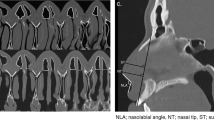Abstract
Correction of caudal septal deviation is a challenging issue because of its significant role in tip support mechanisms. Some interventions especially aggressive resection of caudal septum to correct deviation, may compromise external nasal valve, tip ptosis and persistence of nasal obstruction. Many surgical techniques have been suggested to correct this type of nasal septal deviation. This study presents a technique to correct caudal septal deviation without weakening of tip support mechanisms. To evaluate the efficacy of insertion of a transcutaneous columellar strut during correction of caudal septal deviation. The study was performed in patients complaining from nasal obstruction with caudal septal deviation. After intranasal incision and elevation of mucoperichondrial flap, Caudal septum released from anterior nasal spine (ANS) and a band of cartilage removed from inferior and caudal part of septum and septum again fixed to ANS. Through a vertical transcutaneous incision, a cartilaginous strut is placed in columella, between medial crurae. Preoperative and postoperative NOSE score determined and photographs were taken. In 14 patients we performed this technique, the postoperative NOSE score showed significant improvement, (p = 0.001). Nasal breathing improved in all patients without any complication or tip ptosis or worsening of nasal appearance. This septoplasty technique along with placement of transcolumellar strut, is an easy, efficient and complication free method for simultaneously correction of caudal deviation of nasal septum, reinforcing external nasal valve and prevents tip ptosis.


Similar content being viewed by others
References
Chandra RK, Patadia MO (2009) Diagnosis of nasal airway obstruction. Otolaryngol Clin N Am 42:207–225
Haack J, Papel ID (2009) Caudal septal deviation. Otolaryngol Clin N Am 42(427–36):4
Giacomini P, Lanciani R, Di Girolamo S, Ferraro S, Ottaviani F (2010) Caudal septal deviation correction by interlocked graft technique. Ann Plast Surg 65:280–284
Shaida AM, Kenyon GS (2000) The nasal valve: changes in anatomy and physiology in normal subjects. Rhinology 38:7–12
Lee J, White WM, Constantinides M (2009) Surgical and nonsurgical treatments of the nasal valve. Otolaryngol Clin N Am 42:495–511
Barrett DM, Casanueva FJ, Cook TA (2016) Management of the nasal valve. Facial Plast Surg Clin N Am 24:219–234
Grymer LF, Hilberg O, Elbrond O, Pedersen OF (1989) Acoustic rhinometry: evaluation of the nasal cavity with septal deviations, before and after septoplasty. Laryngoscope 99:1180–1187
Garcia LBS, de Oliveira PW, de Aguiar Vidigal T, de Magalhaes Suguri V, de paula Santos R, Carlos Gregorio L (2011) Caudal septoplasty: efficacy of a surgical technique-preliminary report. Braz J Otorhinolaryngol 77:178–184
Metzenbaum M (1929) Replacement of the lower end of the dislocated septal cartilage versus submucous resection of the dislocated end of the septal cartilage. Arch Otolaryngol 9:282–296
Ellis MS (1980) Suture technique for caudal septal deviations. Laryngoscope 90:1510–1512
Kridel RWH, Scott BA, Foda HMT (1999) The tongue-in-groove technique in septorhinoplasty a 10-year experience. Arch Facial Plast Surg 1:246–256
Digman RO (1956) Correction of nasal deformities due to defects of the septum. Plast Reconstr Surg 18:291–304
Zimbler MS (2015) Aesthetic facial analysis. In: Flint PW, Haughey BH, Lund VJ, Niparko JK, Robbins KT, Thomas JR, Lesperance MM (eds) Cummings otolaryngology head and neck surgery, 6th edn. Elsevier Saunders, Philadelphia, pp 273–285
Stewart MG, Witsell DL, Smith TL, Weaver EM, Yueh B, Hannley MT (2004) Development and validation of the nasal obstruction symptom evaluation (NOSE) scale. Otolaryngol Head Neck Surg 130:157–163
Jang YJ, Yeo NK, Wang JH (2009) Cutting and suture technique of the caudal septal cartilage for the management of caudal septal deviation. Arch Otolaryngol Head Neck Surg 135:1256–1260
Chung YS, Seol JH, Choi JH (2014) How to resolve the caudal septal deviation? clinical outcomes after septoplasty with bony batten graft. Laryngoscope 124:1771–1776
Surowitz J, Lee MK, Most SP (2015) Anterior septal reconstruction for treatment of severe caudal septal deviation: clinical severity and outcome. Otolaryngol Head Neck Surg 153:27–33
Kim DW, Rodriguez-Bruno K (2009) Functional rhinoplasty. Facial Plast Surg Clin N Am 17:115–131
Sedwick JD, Lopez AB, Gajewski BJ, Simons RL (2005) Caudal septoplasty for treatment of septal deviation aesthetic and functional correction of nasal base. Arch Facial Plast Surg 7:158–162
Constantine FC, Ahmad J, Geissler P, Rohrich RH (2014) Simplifying the management of caudal septal deviation in rhinoplasty. Plast Reconstr Surg 134:379e
Anderson JR (1984) A reasoned approach to nasal base surgery. Arch Otolaryngol 110:349–358
Westreich RW, Lawson W (2008) The tripod theory of nasal tip support revisited the cantilevered spring model. Arch Facial Plast Surg 10:170–179
Sadeghi M, Saedi B, Sazegar AA, Amiri M (2009) The role of columellar struts to gain and maintain tip projection and rotation: a randomized blinded trial. Am J Rhinol Allergy 23:47e–50e
Bloom DC, Cupp CL (2003) The percutaneous columellar strut. Am J Rhinol 17:357–361
Aiach GC, Gerbault OF, Kelly MH (2011) Secondary rhinoplasty. In: Nahai F (ed) The art of aesthetic surgery principles and techniques, 2nd edn. Quality Medical Publishing, ST. Louis, pp 2024–2100
Acknowledgement
We would like to acknowledge our artist, Miss Maryam Maher.
Author information
Authors and Affiliations
Corresponding author
Ethics declarations
Conflict of interest
The authors declare that they have no conflict of interest.
Rights and permissions
About this article
Cite this article
Ghorbani, J., Ganjali, M., Givehchi, G. et al. Transcutaneous Columellar Strut for Correcting Caudal Nasal Septal Deviation. Indian J Otolaryngol Head Neck Surg 70, 346–350 (2018). https://doi.org/10.1007/s12070-018-1339-y
Received:
Accepted:
Published:
Issue Date:
DOI: https://doi.org/10.1007/s12070-018-1339-y




